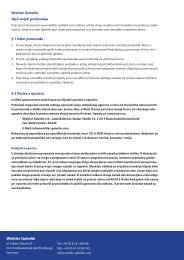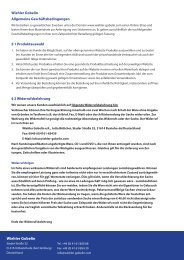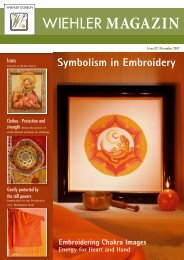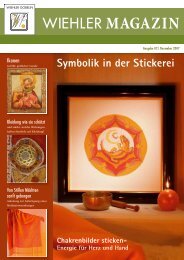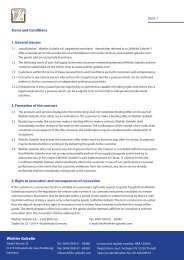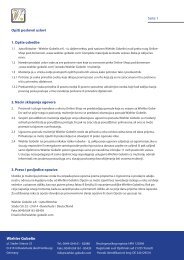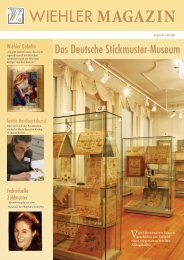Wiehler MAGAZIN - Wiehler Gobelin
Wiehler MAGAZIN - Wiehler Gobelin
Wiehler MAGAZIN - Wiehler Gobelin
You also want an ePaper? Increase the reach of your titles
YUMPU automatically turns print PDFs into web optimized ePapers that Google loves.
As a result of my training I did not develop<br />
my special interest in textiles until later,<br />
but also discovered in it that spirit of timeless<br />
beauty that I had already learned to<br />
recognise and sense during my travels with<br />
my parents.<br />
Before industrialisation the<br />
occupation of an embroiderer<br />
was also a male domain. But it<br />
was a profession which gained<br />
great recognition – and was even<br />
organised in various guilds.<br />
I never experienced embroidery as something<br />
suppressive but – on the contrary<br />
– as a form of art that could lend a unique<br />
expressiveness to something special and<br />
can still do today!<br />
Regarded from a historic point of view this<br />
“prejudice” which has tainted embroidery<br />
is anything but justified. Such a narrowminded<br />
attitude is only a sign of a lack of<br />
knowledge – as is often the case in the field<br />
of textile art.<br />
Before industrialisation the occupation of<br />
an embroiderer was also a male domain.<br />
But it was a profession which gained great<br />
recognition – and was even organised in<br />
various guilds. The profession of embroiderer<br />
was one of few in which the wives<br />
could work with them too and often<br />
enough – e.g. after the death of the husband<br />
– they took over the workshop.<br />
As is partly the case today, there were also<br />
nuns and beguines who earned their living<br />
as embroiderers.<br />
There is no suppression of the women to be<br />
seen in this – on the contrary, it is one of the<br />
few fields of occupation in which women<br />
could already experience relative recognition<br />
and independence at an early age.<br />
I see myself personally tying in with this<br />
tradition, so with the help of my work I<br />
was taking a step towards self-determination<br />
as a person. For me embroidery was<br />
never something “suppressive”, but something<br />
underestimated and suppressed:<br />
in general today the sensitivity for a fine<br />
hand-made and expressive ornamentation<br />
has been lost.<br />
And yet we are still yearning for it, like<br />
e.g. the precision with which clothing for<br />
current historic or fantasy films are reproduced<br />
– not cheap costumes but genuine<br />
clothing. I have also observed a hobbytrend<br />
towards making historic robes.<br />
Jutta Böttcher: If I ask you now what you love<br />
about your work, then you will probably<br />
base your answer on this experience, I suppose?<br />
M. J. Karbig: Correct - I love the tasteful<br />
ornamentation of sacred vestments – and<br />
I love the calming effect of my work. It is<br />
also my work that makes the balancing act<br />
between family and profession considerably<br />
easier.<br />
Jutta Böttcher: So in your work you experience<br />
something that other people are<br />
urgently searching for in their spare time in<br />
order to find the necessary counter weight<br />
to their stressful everyday lives.<br />
However, embroidery alone has not been<br />
sufficient for you as a professional background.<br />
After all you are not only a qualified<br />
embroiderer but also you studied design<br />
after completing your handicraft apprenticeship.<br />
Could you tell us what you consider<br />
to be the significance of this path that you<br />
have taken?<br />
M. J. Karbig: The study of design makes it<br />
possible for me today to grasp the individual<br />
requirements of my customers as exactly as<br />
possible and to realise them in a design that<br />
I then transpose into reality using my art<br />
– parament embroidery.“ During my studies I<br />
learned the tools of design: drawing, precise<br />
observation, composition and the theory of<br />
colours. The talent to imagine things and to<br />
bring them exactly onto paper (and fabric) is<br />
a gift of God.<br />
Jutta Böttcher: This brings us to the next<br />
question. What type of people commission<br />
you to produce such costly robes and ornament<br />
them with your embroidery?<br />
M. J. Karbig: They are mostly pastors who<br />
come from parishes that place importance<br />
on a parament that is not “off-the-shelf”.<br />
They mostly order vestments for festive<br />
occasions.<br />
The young deacons are usually just about to<br />
be ordained. (First they are given the lower<br />
<strong>Wiehler</strong> <strong>MAGAZIN</strong> – May 2007 Page<br />
ordination, the deacon ordination so that<br />
they can then be ordained as priests; if the<br />
priest then possibly goes into a parish, he<br />
then becomes a “pastor” = shepherd). That<br />
is a great step in life which they like to<br />
arrange for themselves and in deep contact<br />
with the congregation. They wish to receive<br />
the special power of the anointment in just<br />
as special a vestment and furthermore to<br />
pass on their first blessing. The newly sewn<br />
vestment has something original, pure<br />
about it that can be filled with the power<br />
of the blessing. Knowing of this effect it is<br />
very important to the prospective priests<br />
and also the congregations that they wear a<br />
valuable and expressive parament.<br />
With the ornamentation of the vestment<br />
worn for the blessing that is individually<br />
embroidered for them, the young priests<br />
like to manifest to all around them what is<br />
near and dear to them, what is very personal<br />
to them. Often the individual design of<br />
the vestments expresses the results of a long<br />
personal process that has been developed<br />
during their years of study.<br />
By the way, in a complex work<br />
of this kind the embroidery also<br />
changes its role. Besides the pure<br />
finishing process it then become a<br />
means of conveying a message.<br />
The relatives of the young priests are keen<br />
to give them something precious just once<br />
more – before they enter into a life of absolute<br />
modesty – and the congregations know<br />
that they are partaking of the power of the<br />
blessing of the priests’ ordination in the<br />
form of the first blessing via the charismatic<br />
power of the vestments.<br />
Jutta Böttcher: In this connection I remember<br />
in particular a vestment that I saw in<br />
your workshop just before it was delivered.<br />
In it you had integrated such „hot“ topics<br />
such as the events of 09/11 or even the<br />
terrible tragedy of the tsunami, Christmas<br />
2004. Could you tell us something about<br />
the circumstances that led this customer to<br />
you?<br />
M. J. Karbig: Yes, that was indeed a special<br />
vestment on which a whole interpretation<br />
of the topic “The fate of mankind and the<br />
answer given by God” was depicted in the<br />
embroidered motifs.



